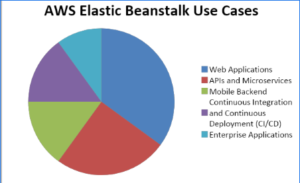Introduction
AWS Elastic Beanstalk is a powerful cloud service that simplifies the deployment and management of applications by automating the provisioning of infrastructure, including servers, databases, and networking. Supporting a wide range of programming languages, Elastic Beanstalk allows developers to focus on writing code while AWS handles tasks like load balancing, scaling, and monitoring. Ideal for various use cases, such as web applications, APIs, mobile backends, and enterprise solutions, Elastic Beanstalk offers a flexible, scalable, and cost-effective environment. With its ease of use and integration with other AWS services, it is a preferred choice for professionals as well as businesses.
What Is AWS?
AWS (Amazon Web Services) is a comprehensive cloud computing platform offered by Amazon. It provides a wide range of services, including computing power, storage, databases, machine learning, and networking, delivered over the Internet. AWS enables businesses to scale and grow by offering on-demand access to resources, eliminating the need for upfront infrastructure investments. It supports various industries and use cases, from hosting websites and applications to running big data analytics and deploying AI models. AWS’s global infrastructure and extensive service portfolio make it a leading cloud service provider, trusted by professionals like AWS Certified Developer Associate and enterprises alike.
All About AWS Elastic Beanstalk
AWS Elastic Beanstalk is a fully managed service that simplifies the deployment and management of applications in the AWS cloud. It automates the provisioning of infrastructure, such as servers, databases, and networking, allowing developers to focus on writing code. Elastic Beanstalk supports a variety of programming languages, including Java, .NET, Python, Ruby, Node.js, and PHP.
To use Elastic Beanstalk, developers upload their code, and the service automatically handles tasks like load balancing, scaling, monitoring, and patching. It also integrates with other AWS services, such as RDS for databases and S3 for storage. Elastic Beanstalk provides a flexible environment where developers can retain full control over the underlying resources if needed, while also benefiting from AWS’s scalability and reliability. It’s ideal for quickly deploying and managing web applications and services without worrying about the underlying infrastructure.
Features And Benefits Of AWS Elastic Beanstalk
AWS Elastic Beanstalk offers several features and benefits that make it a powerful choice for deploying and managing applications in the cloud:
Features:
- Multi-language Support: Elastic Beanstalk supports popular programming languages like Java, .NET, Python, Ruby, Node.js, PHP, and Go, providing flexibility in application development.
- Automated Provisioning: It automates the deployment process, handling infrastructure provisioning, load balancing, auto-scaling, and monitoring, freeing developers from manual setup.
- Customization: Developers have full control over the underlying resources, allowing customization of the environment, including server instances, storage, and networking configurations.
- Integrated Monitoring: Elastic Beanstalk integrates with Amazon CloudWatch, providing real-time monitoring of application performance and health, with easy access to logs.
- Environment Management: It offers features like versioning, rolling updates, and blue/green deployments, ensuring smooth application updates and minimizing downtime.
Benefits:
- Ease of Use: Elastic Beanstalk simplifies application deployment with its user-friendly interface and automated workflows, making it accessible even for those with limited cloud experience. Therefore, getting the AWS Certification can be beneficial for aspiring AWS professionals.
- Cost-Effective: Users only pay for the underlying AWS resources consumed, with no additional charges for Elastic Beanstalk itself, making it a cost-efficient option.
- Scalability: Automatically scales applications to handle varying levels of traffic, ensuring optimal performance without manual intervention.
- Reduced Management Overhead: By managing the underlying infrastructure, Elastic Beanstalk allows developers to focus on coding and improving applications rather than dealing with operational complexities.
These features and benefits make AWS Elastic Beanstalk a robust solution for quickly deploying and managing scalable, reliable applications in the cloud.
AWS Elastic Beanstalk Use Cases
AWS Elastic Beanstalk is versatile and supports a wide range of use cases, making it a popular choice for different types of applications:
1. Web Applications:
Elastic Beanstalk is ideal for deploying and managing web applications. Professionals like the AWS Certified Developer Associate can quickly deploy scalable websites and web services without worrying about the underlying infrastructure. It supports languages like Java, PHP, and Node.js, making it suitable for a variety of web frameworks and architectures.
2. APIs and Microservices:
Elastic Beanstalk is well-suited for deploying APIs and microservices, especially in environments where scalability and reliability are crucial. It allows developers to deploy API backends and microservices, manage them independently, and scale them automatically based on demand.
3. Mobile Backend:
Elastic Beanstalk can be used to deploy and manage backends for mobile applications. It simplifies the process of setting up RESTful APIs, handling authentication, and managing databases, allowing mobile app developers to focus on building the client-side experience.
4. Continuous Integration and Continuous Deployment (CI/CD):
Elastic Beanstalk integrates well with CI/CD pipelines, enabling automated deployments and testing of applications. This is beneficial for organizations that need to deploy updates frequently and want to ensure seamless integration with their development workflows.
5. Enterprise Applications:
Elastic Beanstalk is also suitable for deploying enterprise applications that require high availability, security, and compliance. It supports deploying complex multi-tier applications with databases, application servers, and caching layers, ensuring that enterprise-grade applications are robust and scalable.
These use cases demonstrate the flexibility and power of AWS Elastic Beanstalk in supporting various types of applications, from simple websites to complex enterprise solutions. The AWS Certification course offers the best guidance in this field.
Here’s a pie diagram representing the different AWS Elastic Beanstalk use cases and their percentage.
This distribution is based on common scenarios, but the actual usage percentages may vary depending on specific organizational needs and industry trends.

Conclusion
AWS Elastic Beanstalk is a versatile, fully managed service. It simplifies application deployment and management across various use cases, including web applications, APIs, mobile backends, CI/CD, and enterprise solutions. Moreover, it offers scalability, ease of use, and cost-effectiveness, making it a valuable tool for developers and businesses alike.

